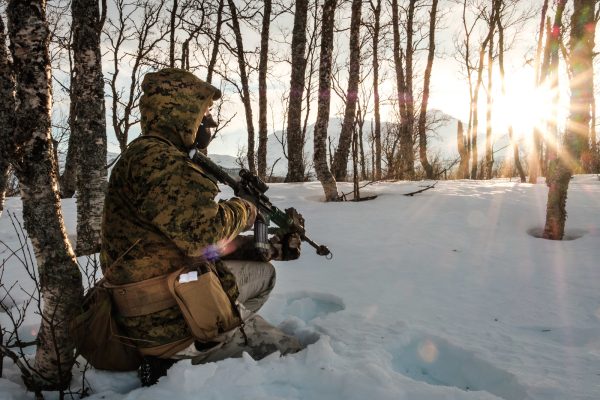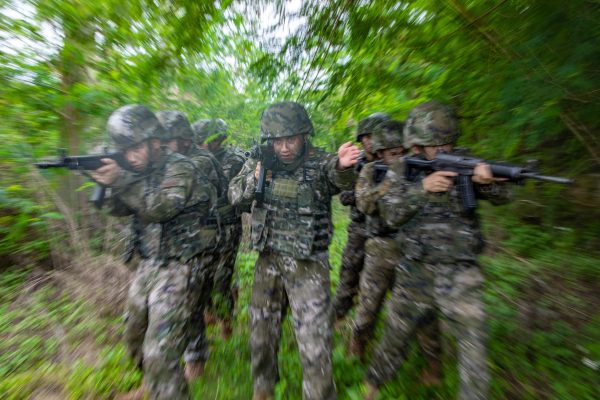The war in Ukraine has shown that Russia’s military is heavily reliant on a range of missile systems — on the night of June 25 alone, it fired 48 cruise missiles at targets in Ukraine. It appeared some weeks ago that missile stocks were running out, and that the Russian Armed Forces was having to fall back on stocks of inferior, Soviet-designed missiles.
Yet Russian missiles are still being produced.
The state defense order, that is the budget allocated for the production of the latest weapons, went into decline in 2020, with the lack of production funds balanced by loans. Needless to say, the war with Ukraine has significantly rebuilt the order books of the country’s defense industry and now the Russian budget is in surplus, given its huge income from oil and gas exports.
From January to May, the Russian Federation’s budget was in surplus by more than 1.49 trillion rubles ($27bn according to the Central Bank of Russia.) Spending on national defense from February to April (spending for May is classified for the first time) increased by 180%. Judged against expenditure in April 2021, spending in April 2022 was 38% higher. According to the first deputy chairman of the Board of the Military-Industrial Commission Andrey Yelchaninov, the state defense order is guaranteed to grow by 600-700 billion rubles this year.
There is much hard work underway to fill the missile deficit. Since May, two missile plants have been working more actively than others. The first is the Novator plant – which manufactures missiles for the Iskander and Buk systems, Kalibr missiles, and several ship-based missiles. The company produces about 100-120 Kalibr units annually and several dozen cruise missiles for the Iskander system. The depletion of missile stocks required the intervention of the presidential plenipotentiary representative in the Ural Federal District, Vladimir Yakushev, who apparently guaranteed that the plant would receive additional cash — since May, the plant has been working around the clock in three shifts. Even so, the factory is struggling to significantly increase volumes given its need for a large number of additional engineers, mechanics, and other technical workers.
The second company working around the clock is the manufacturer of ballistic missiles for the Iskander, the Yars complex, and the Bulava missile – the Votkinsk Plant. In 2020, it switched to a four-day working week, shedding employees of retirement age and employees of subsidiaries. Now the situation has changed, and it is seeking an additional 500 staff. Obviously, the increase in production is associated with the need to replenish missiles for the Iskander complex. Production has risen to about 60 missiles from about 50 a year earlier.
But the round-the-clock work of these plants will increase production by no more than 20%, due to shortages of skilled workers.
Many other plants work in two shifts and all additional technical and human resources have been mobilized to meet the increased needs of the Ministry of Defense.
The growth of military production is also shown by other examples. For example, the Miass Machine-Building Plant, which manufactures housing components and missile nodes for marine ballistic missiles, and hardware for marine missile systems. Last year, the company filed for bankruptcy, as due to a lack of orders, was unable to pay its loans and often worked on a reduced schedule. Now the situation has changed, despite the fact that bankruptcy proceedings continue, because the plant has apparently received an order since the outbreak of war, and the need for new workers at the plant has grown eightfold.
Or take the Strela plant in Tula, which produces Onyx missiles. A couple of years ago, it suffered a reduced order from the state, workers were put on minimum salary and were looking for other jobs. Since May, however, the plant has opened up more than 200 new positions.
Surprisingly, the Tactical Missiles Corporation, which creates air-launched cruise missiles Kh-101, Kh-59, Kh-32, and others, has not been a beneficiary in this intensification of military production. Although it worked around the clock during parts of Russia’s war in Syria in 2015, there is no such activity now. Probably the air force has been less active in Ukraine, and anyway, there may be a lack of components to increase production.
All major defense plants have been hit by sanctions. Many were first affected in 2014 following the annexation of Crimea, and were then tasked with import substitution of foreign components. The main problem of the Russian defense industry is electronics. From 2008 to 2015, there was a federal program for the development of electronics and radio electronics. But it failed.
Russia could produce its own defense electronics, but the backwardness in this high-tech sphere is so great that the reliability of the products is significantly lower, and the cost is significantly higher. Even if the government decided to buy expensive and insufficiently efficient electronic components in Russia, no plant in Russia can provide the required volume.
That’s why since 2014 the problem was often solved through the creation of front companies to secretly buy necessary components from abroad. In 2019, the share of foreign electronic components in Russian goods was estimated at 80%.
For example, the Iskander 9M723 and 9M728 missiles have been using American gyroscopes and accelerometers from Analog Devices since at least 2009, which continued to be used in 2017, and which were apparently used in missiles launched against Ukraine in 2022. This indicates that despite sanctions and the import substitution program, Russian enterprises were unable to produce electronics for the defense industry.
In order to reduce dependence, the government made another attempt in 2019 and intended to create a consortium of enterprises to create radio electronic products by 2025. But the base and models for production would still be foreign components. There was no time to implement this plan before the latest conflict.
New sanctions have further limited the supply of Western components to Russian companies. For now, to ensure uninterrupted operation, stocks of foreign electronic components are being used. These should have been sufficient for two to three years of normal production. But with the demands of war (Ukraine says more than 2,500 Russian missiles have been fired) and an increase in output, these stocks may run out next year. To solve this problem, supply chains are being reviewed and suppliers are being sought in other countries that have not imposed sanctions and are ready to cooperate.
Yet this is extremely complicated. Guided missiles have strict requirements for dimensions and mass. With each replacement of components, additional tests will need to be carried out, and this will cause significant increases in costs deterioration of technical performance, not to mention an increase in production time. Russian missiles are probably not always effective anyway, and their quality will therefore degrade even more.
The growth of Russian budgetary income has allowed missile plants to greatly expend their order books. But even increased production in the near future will not replace the volume of missiles spent in four months of the war. Replenishing the reserves will take several years.
The impact of Western sanctions and the failure of domestic substitution efforts means that Russia’s rocket industry faces a stark choice —replenish electronic components abroad in 2022, or face an all-out crisis.
Maxim Starchak is an independent expert on Russian nuclear policy, defense, and the nuclear industry. Based in Moscow, he is a Fellow at the Centre for International and Defence Policy of Queen’s University in Canada, and a contributor to the Jamestown Foundation’s Eurasia Daily Monitor. He has also written for the Atlantic Council, FPRI, Marshall Center, and others.




